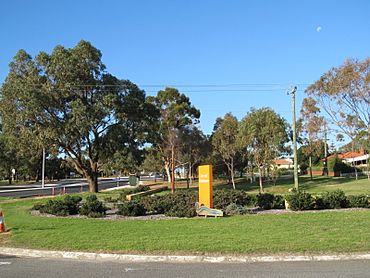Coolbellup, Western Australia facts for kids
Quick facts for kids CoolbellupPerth, Western Australia |
|||||||||||||||
|---|---|---|---|---|---|---|---|---|---|---|---|---|---|---|---|

City of Cockburn sign at Stock Road, Coolbellup.
|
|||||||||||||||
| Postcode(s) | 6163 | ||||||||||||||
| Area | 3.1 km2 (1.2 sq mi) | ||||||||||||||
| Location | 15 km (9 mi) from Perth | ||||||||||||||
| LGA(s) | City of Cockburn | ||||||||||||||
| State electorate(s) | Willagee | ||||||||||||||
| Federal Division(s) | Fremantle | ||||||||||||||
|
|||||||||||||||
Coolbellup is a suburb in Perth, Western Australia. It's about 15 kilometers south of the city center. It's part of the City of Cockburn, which is like its local council area.
The name Coolbellup comes from an Aboriginal word. It was the name for a nearby lake, North Lake. Before 1957, the whole area was actually called North Lake!
Contents
Coolbellup's Past: A Look at Its History
Who Lived Here First?
Long ago, the first people to live here were the Noongar people. They came from the Swan River area. They set up their camps near Perth's central lakes. This helped them avoid the salty lakes closer to the coast. Sixteen Aboriginal campsites have been found in the City of Cockburn.
How Coolbellup Got Its Name
Coolbellup was once part of a large piece of land owned by George Robb. The name Coolbellup was first written down in 1842. It was the Aboriginal name for a lake near the land's edge. Later maps showed both "Coolbellup" and "North Lake" for the area. This lake is the most northern of many lakes between Mandurah and the Swan River.
From Farms to Homes
In the 1920s, most of Coolbellup was used for dairy farms. But a cattle disease ended the dairy industry here. An abattoir (a place where animals are prepared for meat) also operated until the 1950s. There was even a vineyard! It grew grapes until the late 1970s. That land was then used to build houses for the suburb of North Lake.
Much of the land was still natural bushland. Many native animals, like kangaroos, lived there. In 1954, the government bought most of the land. They started a big housing project after World War II. In 1957, they officially decided to call the suburb Coolbellup instead of North Lake.
Growing Up in the 1960s
During the 1960s, many families moved to Coolbellup. They bought modern brick houses on big blocks of land. The state government offered low-cost loans to help them. Some apartment buildings were also built. The Coolbellup Shopping Centre opened in the middle of the suburb. Next to it was the Coolbellup Motor Hotel, which was taken down in 2014.
By the late 1980s, Coolbellup's population boom slowed down. The area changed from mostly young families to more older residents. The suburb also needed some updates.
Making Coolbellup New Again
In the late 1990s, a project started to make Coolbellup better. Older apartment buildings were taken down and replaced with newer, nicer homes. Some apartments were also made into high-quality living spaces. Roads, parks, and sports fields were also improved.
These changes, along with Coolbellup's good location, made property values go up a lot. Many government-owned houses were sold to private owners. The typical houses are 1960s style. They have three bedrooms, one bathroom, and solid timber floors. They sit on large blocks of land, about 700 square meters. These older homes are now popular with younger couples and families. They like the character of these homes, which are still close to the city center.
Coolbellup's Location and Natural Features
Coolbellup is surrounded by several roads. Winterfold Road is to the north. Stock Road is to the west. North Lake Road is to the east. Forrest Road and the Roe Highway are to the south. Some of the main streets inside Coolbellup are Coolbellup Avenue, Counsel Road, and Waverley Road.
The land in Coolbellup is gently rolling. The highest spots are around Coolbellup Avenue and Waverley Road. The only lakes nearby are North and Bibra Lake. These lakes are no longer officially inside the Coolbellup area.
Places to Go and Things to Do in Coolbellup
Parks and Community Spots
Coolbellup has several parks. The main one is Len Packham Reserve. It's on Waverley Road, behind the Coolbellup Shopping Centre. This park is used for soccer training. It also has basketball courts and a skatepark. The Coolbellup library is also nearby on Cordelia Avenue. Another big park is Tempest Reserve on Coolbellup Avenue. This is where the Coolbellup Australian Football Club plays.
Schools in Coolbellup
Coolbellup used to have three state primary schools: Coolbellup, East Coolbellup (later North Lake Primary), and South Coolbellup (later Koorilla Primary). These schools closed because fewer young families and children lived in the suburb. A new school, Coolbellup Community School, was built on Len Packham Reserve. The old school sites were then used for new housing.
A high school, North Lake Senior High School, opened in 1973. It was built in what used to be a pine forest. This area is now known as Somerville or Kardinya. The high school closed in 1993. It is now an adult education school called North Lake Senior Campus.
Churches
There are two churches in Coolbellup. You can find a Baptist Church and a Uniting Church, both on Waverley Road.
Getting Around: Transport in Coolbellup
Bus Routes
Coolbellup has several bus routes that help people get around:
- Route 115: Travels from Hamilton Hill Memorial Hall to Elizabeth Quay Bus Station. It uses Counsel Road, Waverley Road, and North Lake Road.
- Route 511: Goes from Fremantle Station to Murdoch Station. It uses Winterfold Road.
- Route 512: Also goes from Fremantle Station to Murdoch Station. It uses Coolbellup Avenue, Cordelia Avenue, Romeo Road, and Waverley Road.
- Route 513: Another route from Fremantle Station to Murdoch Station. It uses Counsel Road, Leece Street, Cordelia Avenue, Coolbellup Avenue, and Winterfold Road.
- Route 520: Connects Fremantle Station to Cockburn Central Station. It uses Forrest Road.

